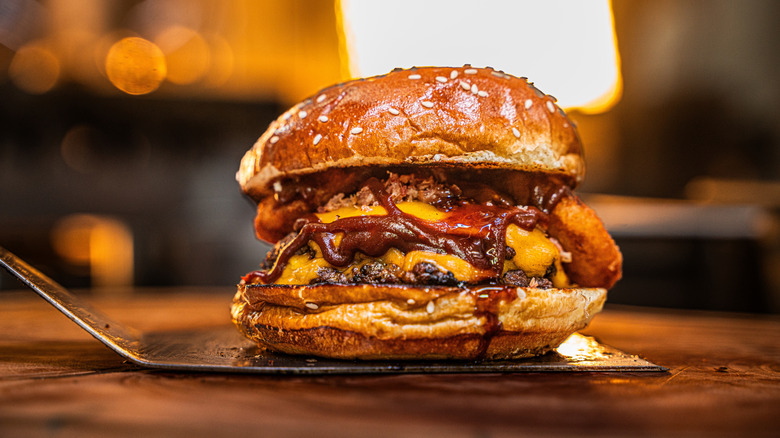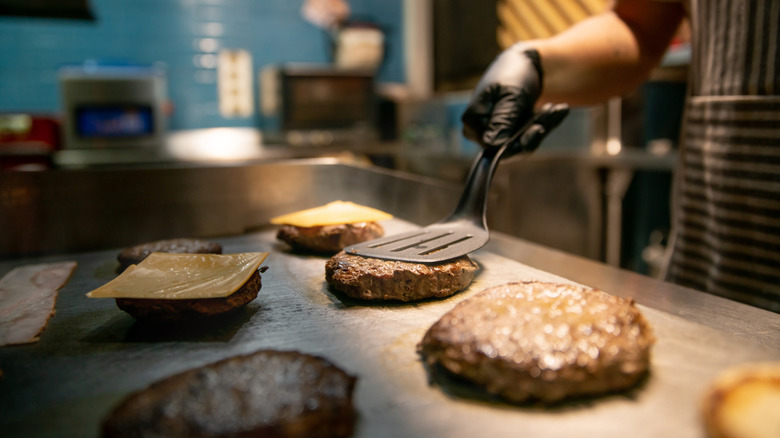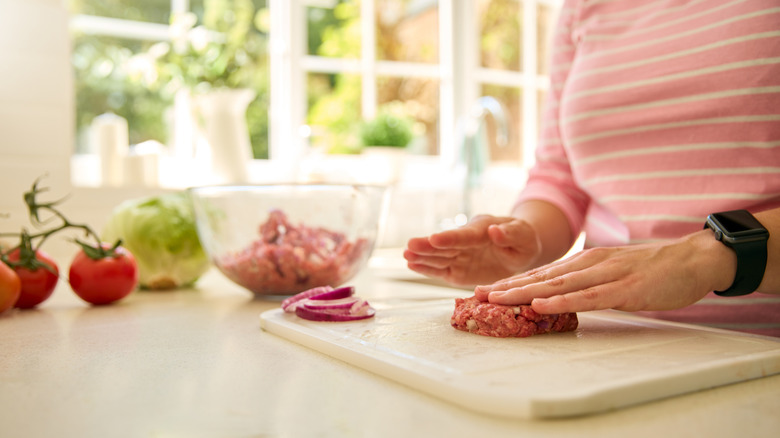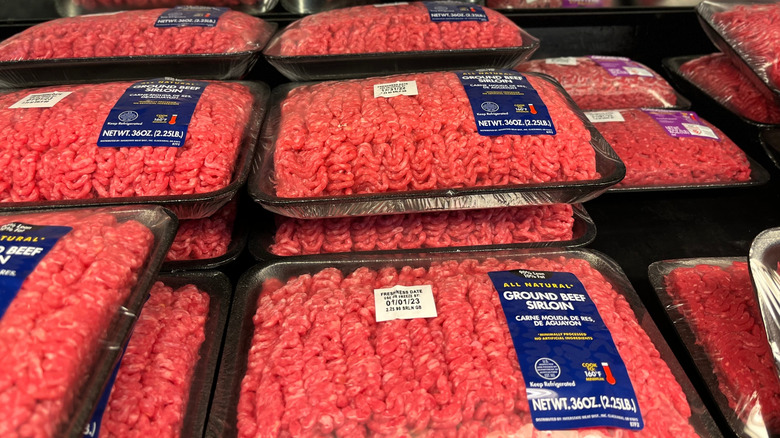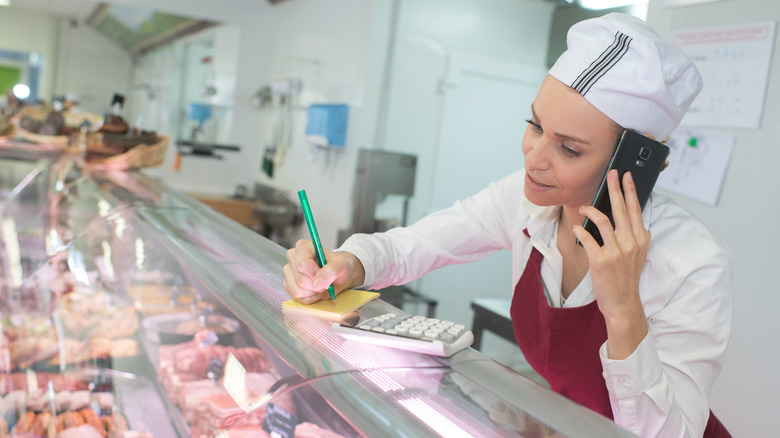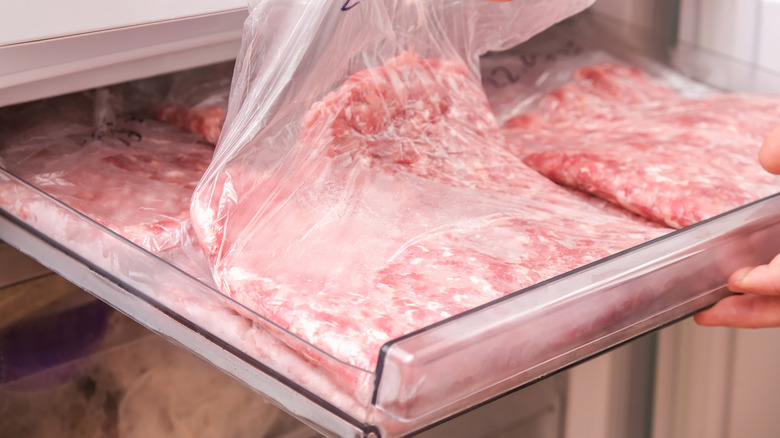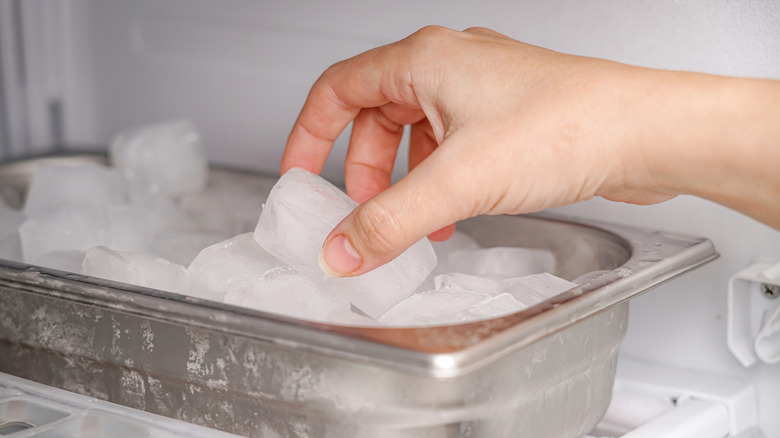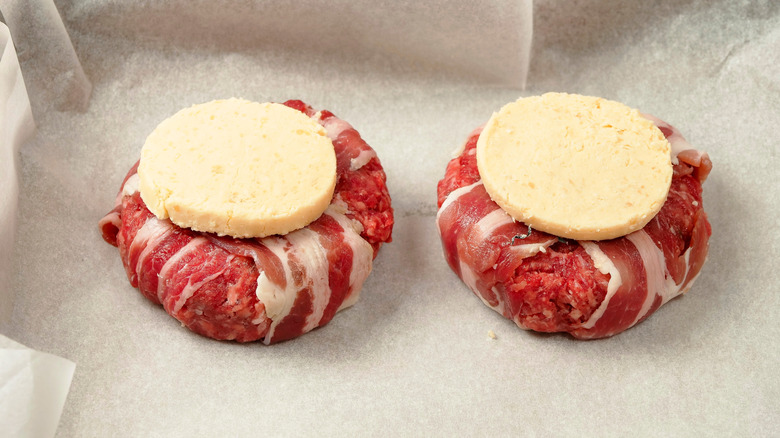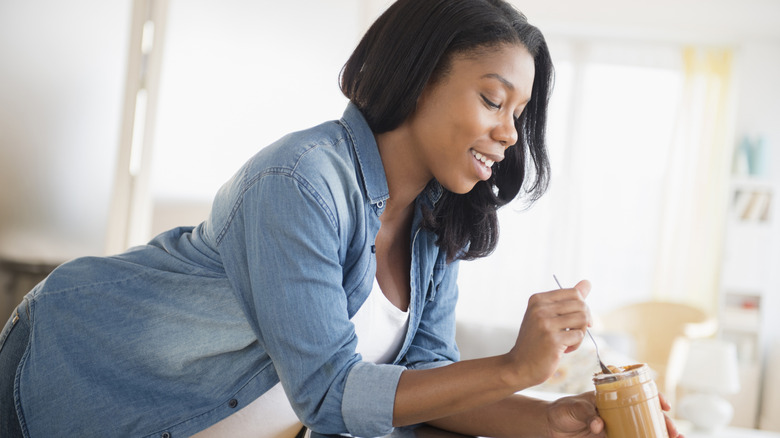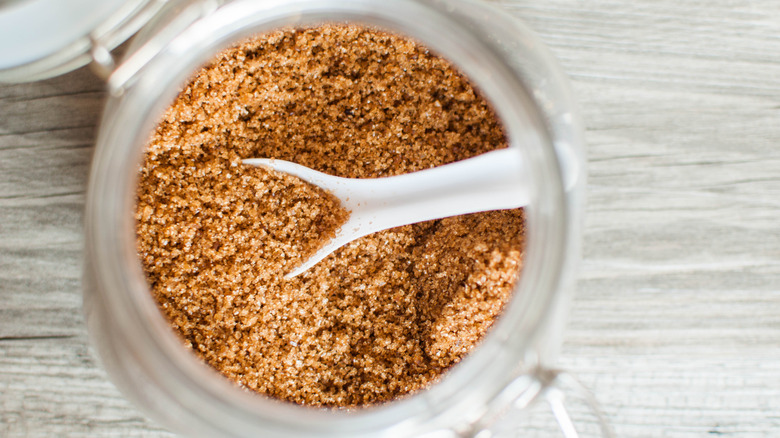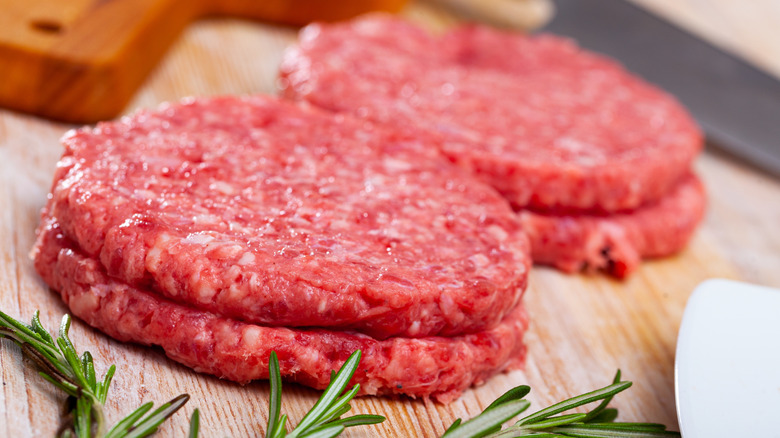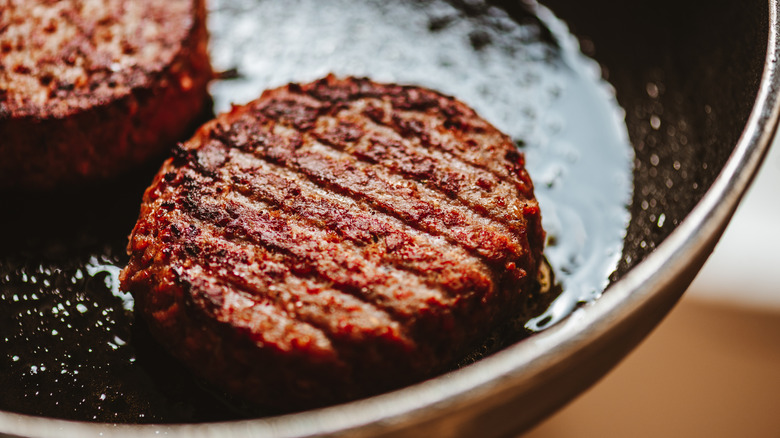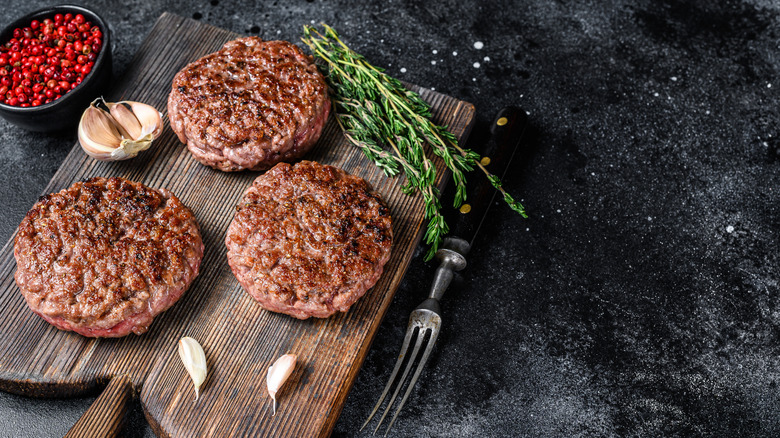12 Tips For The Juiciest Burgers You've Ever Tasted
There's a big difference between a "good" burger and a "bad" burger — and, often, those "bad" burgers are lacking one key thing: moisture. Think about it. Imagine the best burger you've ever eaten, and then the worst burger you've ever eaten. The former, whether you prefer a smash burger with simple accompaniments or a thick stuffed patty piled high with decadent toppings, was likely juicy and mouthwatering, with plenty of fatty goodness accentuating all the burger's beefy flavors. The latter, meanwhile, could've probably been likened to a piece of cardboard, with little flavor, moisture, or heft.
However, achieving that amazing, moist, juicy burger isn't always easy. There are many mistakes you can make that can lead you down that path to a cardboard-esque beef patty. So what's the best way to cook up some of the juiciest burgers you've ever tasted? No, you shouldn't just go to your favorite local burger joint and let the pros do the work. Here are some basic tips to achieve the ultimate juicy burger at home.
Don't press your patty
It can be tempting to press your burger patty down into a nice, round puck. Especially if you're cooking a smash burger, pressing is part of the process, right? However, if you're aiming for the juiciest burger possible, you need to resist the urge to press your burger patties down whether you're using a burger press or a spatula on the grill.
Pressing burger patties is one of the major mistakes that will dry out a burger fast. Not only does pressing down on a burger patty push moisture out of the patty (you'll likely notice that when you do, the burger sizzles somewhat satisfyingly — satisfaction aside, that noise is the moisture leaving the beef), but it also doesn't really do anything to help the burger cook evenly, as you might suspect. Even with smash burgers, you're not really supposed to keep smashing them into your cooking surface, as that'll make for a dry smash burger. Instead, you only need the one, flattening smash. If you're worried about your burger cooking unevenly because you're not pressing it down on all sides, take extra care when shaping the burger.
Shape your patty correctly
On the note of shaping your burger correctly, doing so will not only help your burger cook evenly, but it will also help with moisture retention. The best way to shape a burger patty to prevent drying out your burger is by forming your desired patty size and shape, and then making a small indention in the middle of the patty (you can use your knuckle or the pad of your thumb to get an indention of the correct size). As the burger cooks, the indention will fill with steam from the hot cooking surface, adding even more moisture to your burger.
As you shape your patty, though, act fast. You don't want to spend a ton of time working and reworking your ground meat into patty shape. Overworking the meat can lead to a burger that's tough and dense, according to Jennifer Borchardt, culinary content director at Pre Brands, who spoke with The Takeout for a past article. She recommended treating your ground beef with "a light touch," as you form each patty. Excess continual mixing can release extra proteins within the ground beef, and this protein — called myosin — acts as a binder that keeps the meat glued together in such a way that's not exactly palatable.
Buy the right mix of beef
The fattier the burger, the harder it is to dry it out. So what's the perfect beef-to-fat ratio that you should look for when choosing ground beef at the grocery store in preparation to grill up some burgers at home?
Look for ground beef that's an 80/20 mix (which means that the beef is 80% lean meat, 20% fat content). This amount of fat will not only help keep the burger from drying out but also help the patty retain your desired shape, as well as add flavor. If you do need something that's on the leaner side (say, if you're trying to watch your overall fat or calorie intake), Jennifer Borchardt at Pre Brands told The Takeout that you should absolutely not go any lower in fat content than a mix that's 85% lean meat, 15% fat. She additionally pointed out that, in many instances, home cooks will buy a leaner mix of beef. When they start to notice that it's drying out while cooking, or when they take that first dry bite, they'll try to counteract it by adding fatty, moisture-adding ingredients. However, when you add something like cheese or mayo to your dry burger, you're only masking the dryness and adding in the extra fat content you were trying to avoid in the first place.
Ask for coarse-ground beef
If you're not buying pre-formed patties or ground beef at the grocery store, but going to a butcher instead, consider asking for coarse-ground beef. If you ask your butcher to run a cut of beef chuck through the grinder at a medium-coarse setting, you'll notice that the fat and lean meat are more evenly combined.
When you pick up the average ground beef or burger patties at the grocery store, you'll find that the grind is fine side rather than coarse. This makes for ground beef that's tightly packed together, which makes for a denser, drier product (very similar to how, if you pack your ground beef together, over and over again, via over-mixing, you'll have a denser, drier burger patty). Keep the fine-ground beef for foods you want denser like meatballs or meatloaf, but opt for coarse-ground beef for something like a burger. It requires extra time waiting for the butcher, but it's well worth it.
Freeze your beef before making patties
Consider switching your patty-making routine with a simple 20-minute freezer trick for juicier burgers. This hack requires fresh, non-frozen beef on hand, but it's proven to produce oh-so-moist results.
What you'll want to do is, take your raw ground beef and spread it out (gently!) on a rimmed cookie sheet that's of a suitable size to pop into your freezer. Once the ground beef is evenly spread across the baking sheet, season it as desired, and throw it in the freezer. Let the beef freeze for just 20 minutes, after which the beef will be firm, but workable. From there, make your patties (again, gently!). If the beef is not pliable enough to make your patties due to the freezing, let it sit for 10 minutes or so, but, again, only until it's workable. You don't want it to go back to being completely thawed.
Once your patties are shaped, cook them as you normally would. The patty will remain uniform, cook evenly, and the internal texture will remain coarse for greater moisture.
Include ice in your patties
Sometimes, the best way to do something is the simplest. If your burgers are lacking moisture, consider simply injecting moisture directly into your patties in the form of the OG moisturizer, water.
That's right. Consider adding ice to your burger patties. This ice cube hack that makes for perfectly moist grilled burgers may surprise you. This hack works in two ways. You can either form your patty around an ice cube or you can press cubes into the top of your pre-formed patties before cooking. Either way, the ice will melt into the ground beef as the patties cook. If you want to take things further, you can mix a few tablespoons of ice water into your ground beef, before forming the patties.
Add butter to your patties
While water certainly adds moisture, it doesn't add any extra flavor. If you want an ingredient that adds moisture and extra flavor, you'll need to look to other options like butter.
There are a few ways you can add butter to your burger patties for the best results. As was advised when adding ice cubes to your burger patties, you can add a pat of butter to your burger patties, completely encasing each pat of butter in ground beef. You can also follow the Paula Deen method. In an exclusive Mashed interview, she noted that she will sometimes freeze butter, cut the frozen butter into chunks, and then mix the chunks evenly into her ground beef, before forming burger patties. This can make for more uniform butter distribution. To ensure the butter is more thoroughly mixed in, consider grating it into the beef.
You might also add even more flavor by using compound butter in your patties instead of just plain butter. Compound butter is easy to make. All you need to do is let your butter soften, mix in your ingredients of choice, and then allow your butter to harden again in the fridge before use.
Add peanut butter to your patties
Peanut butter has long been a somewhat unusual topping for burgers. However, peanut butter's unique flavor matches well with a burger's savory saltiness. To harness peanut butter's flavor and high-fat content, add it to your ground beef the next time you make up some patties. Add a fourth of a cup of peanut butter to a pound of beef. You'll (obviously) want to opt for smooth peanut butter and look for peanut butter with a high fat content (so none of that low-fat nonsense).
Once you've added peanut butter to your patties, consider stretching your creative muscles further by pairing your peanut butter-infused burgers with toppings in complimentary flavors. For example, throw on some bacon, which pairs well with both burgers and peanut butter separately. You might also take the PB&J route and slather your burger bun with your favorite strawberry jam or grape jelly.
Make your burgers with brown sugar
When you reach into your pantry or spice rack for the perfect seasonings and spices to flavor your burgers before they head out to the grill, you're probably not going to reach for the sugar. However, adding brown sugar to your burgers could help them retain moisture.
While you probably don't want to add too much brown sugar to your patties, adding a little bit of a pinch or two can help tenderize the beef for a juicier burger. Additionally, when you incorporate brown sugar into your burgers, the brown sugar will cook first, caramelize, and provide a nice crust to help seal in further flavor and moisture. Caramelization is another reason why you don't want to add too much brown sugar to your burgers. It's easy for sweet caramelization to turn into bitter char, if you have too much brown sugar cooking at high of heat for a long a period.
Trade beef for pork
If you've tried burger hack after burger hack and you're still not seeing the moist, juicy burgers you crave, you might want to try ditching the beef altogether. No, don't replace it with leaner meat like chicken or turkey. Instead, go with a protein that will still offer a fair amount of fat: ground pork. If you do decide to use pork instead of beef, note that you may need to add some binding ingredients to help the pork burger stay in patty form. An egg and about ¾ cup of breadcrumbs will be enough for two pounds of ground pork.
Don't want to add filler like this to your burger? Chef James Taylor of Miami's The Joyce and The Window at The Joyce advised in a past The Takeout article to incorporate ground pork or bacon into your ground beef. Whether you go 100% pork or prefer a pork-beef mixture, though, be sure that you're complimenting your pork patties appropriately, with the right toppings. A spicy mustard, apple-based slaw, pickles, and/or onions are good picks.
Pick the right cooking method
After you've crafted your perfectly moist and juicy patties, you're still not in the clear. No matter how lusciously moist those raw patties are, you could still end up with dry burgers if you cook them the wrong way.
According to Chef James Taylor, the best option for cooking a moist burger is on a hot flat top like a Blackstone griddle. If you don't want to invest in or don't have the room for a Blackstone griddle, he advises using a cast iron pan. Compared to grilling, using one of these options helps seal in all of your juices (rather than losing them to the fire), while ensuring that you don't end up overcooking and burning your burgers.
As you cook your burgers, make sure you don't flip them too often — experts agree that only one flip is typically necessary — and be sure you're not cooking at a super-high temperature. Medium heat allows the burger to cook to your desired doneness on the inside without prematurely burning on the outside.
Let the burgers rest after cooking
Finally, after cooking your burgers, give them ample time to rest. Not allowing them to rest after cooking, and digging in right away, is one of the top mistakes that experts see home cooks make when it comes to burgers. They advise letting your cooked patties rest at room temperature for, at minimum, 30 seconds.
Why is this resting period is so crucial? It allows the fibers within the meat, which contracted during the cooking process, to relax. When the contracted fibers relax, the liquid within the meat, which has all pooled into one spot during the cooking process, redistributes, so that each and every bite of your burger is just as juicy as the last.
Static Media owns and operates The Takeout and Mashed.
